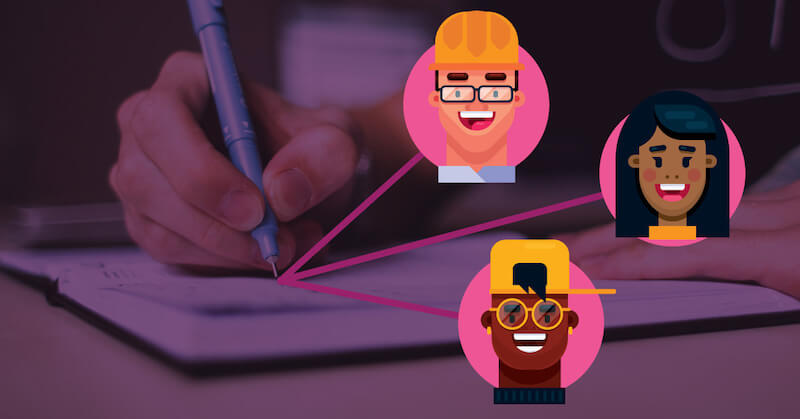How to make a buyer persona

In our previous article, we went over the basics of buyer personas and why you should consider adding them to your marketing toolkit. Now you may be thinking…okay, great, but how do I actually go about making them? Don’t worry – we’ve got your back. In this article, we’ll go over the basics of how to make a buyer persona for your business.
Here are the four steps that will teach you how to make a buyer persona:
How to make a buyer persona: 1. Do thorough research.
There’s no getting out of it: if you want to create a buyer persona that will help you accomplish your goals, you’re going to have to buckle down and do a lot of research. Even if you think you already know who your customers are, you need to actually dig into the data. Here are some of the best sources for that data:

Analytics from past campaigns
The best place to get robust, accurate data for this project is simple: your own records! The more data, the better. Dive into the analytics for your website, social media profiles, and past paid campaigns, and you’ll find a wealth of information. Who were you most likely to reach? What was their path to conversion? Which pages did they view the most? What kind of patterns do you see?
Your sales team
Another great resource for this data is to talk to your sales team (or any other customer-facing employees) to see what insights they can offer. Who have you reached most effectively in the past? What are their demographics? Are there certain demographics you would prefer to avoid? (If you’re trying to reach CEO’s and decision makers, you don’t want to waste your advertising dollars on lower-level employees.)
In addition to clients they’re already working with, your sales team should also consider types of clients they hope to work with in the future and types of clients they know your competition is succeeding with. Creating a persona for an aspirational segment of your audience can help you focus your efforts to reach them. You wouldn’t drive to a new location without a map or GPS! Consider an aspirational buyer persona your GPS.
Direct customer data
Who better to tell you what your customers are like than the customers themselves? Consider sending a survey to some of your existing clients so you can gather some data points. You may need to offer an incentive for them to take the survey – say, a gift card to Starbucks or Amazon – but the information they provide would be well worth it!
The type of questions you’ll want to ask depends on the type of business you run. However, questions like these may be a good starting point:
- Who are the decision makers?
- What age demographic are they?
- Where do they live?
- What is their home life like?
- What are their values?
As you can see, research is probably the most time-consuming step in the process, but it’s also the most important! All this research may seem daunting, but it will provide you with a solid foundation to build your personas.
How to make a buyer persona: 2. Organize your data.
Once you have the data showing who your current and potential future customers are, it’s time to dig a little deeper. What do each of these potential consumers want? Remember, ultimately, everyone is motivated by action – so which groups have similar goals and challenges? How far do you want to go in segmenting them? No two customers are going to be identical, but as you pore through your data, you should start to see patterns that can help you define groups.
Before you dive too deep, you’ll want to first decide how many buyer personas you want to create at this stage. One will likely not be enough, but if you make too many divisions, you’ll end up creating a lot of work for yourself! Consider starting with 2-5 personas, depending on the scale of your business, prioritizing them based on who you want to reach the most. You can always go back later and make more if you need to. After all, you’ve already done the hard work of research!
To get you started, some common ways to segment your buyer personas are to separate them by:
Job title
Industry
Pertinent demographic information
How to make a buyer persona: 3. Craft the persona(s).
Now that you have your research done, and you’ve started to sort through your data, you can finally start crafting the actual personas! It can be tempting to take a generic buyer persona you find online and use that. But while you can look at examples as a starting point, we would advise you to customize it for your business specifically, using the data you gathered in step 1. However, sample buyer personas can be a useful guide. If you need even more guidance, services like Hubspot even have a persona builder tool you can use to help make the process easier.
To help define each persona and help them stick in your brain, it’s helpful to give each persona a unique and descriptive name. You might call your persona of young stay-at-home moms “Stay-at-home Sally,” or your persona of mid-level marketing professionals “Marketing Megan.”
Don’t forget the details!
The goal of creating a persona is to not only collect random facts about the type of customers you’re seeking, but also to craft a story to go with each persona. It’s not enough to know that Marketing Megan works in marketing – maybe she works at a mid-size agency, manages a small team, and is looking for ways to improve efficiency. Perhaps she is an avid Instagram user in her mid-30’s who loves to travel the globe.
Of course, not every single detail is going to apply to everyone, and steps like making a name for the persona or writing down lots of details may seem silly or excessive at first. But the process of crafting a persona and a story to go with it will help the information stick in your mind and, in turn, keep your marketing efforts focused. A buyer persona will help you make the marketing process, well, more personal!
As you put together the persona, make sure you also include a section that addresses their goals and challenges. The more you’re able to identify the obstacles they face, the more you’ll be able to figure out how you can address their needs. Don’t be afraid to get specific! In the end, every company’s buyer personas will be slightly different, but yours may likely include information such as:
-
Age
-
Location
-
Job Title
-
Home Life
-
Outside Activities
-
Business Goals
-
Obstacles
-
Values
-
How your business suits their needs
How to make a buyer persona: 4. Share with your team.
Congratulations – once you reach this step, you’ve made your first buyer persona and are well on your way to running better, more tightly focused marketing campaigns! But a buyer persona is no good if you keep it to yourself. Ideally, you want your entire team to be on the same page. So, make sure that you share your buyer personas with your whole organization. Even employees who aren’t always directly facing customers will benefit from knowing how you’ve segmented your personas. When your team is working from the same information, you’ll be able to create a more focused marketing plan that will benefit your entire organization.
We hope this article has helped you understand how to make a buyer persona. The process of creating buyer personas may seem like a long and daunting one, but we promise that your company will be better off if you take the time to do it! The better you understand your customers, the better you’ll be able to reach them – and that’s what marketing is all about.


